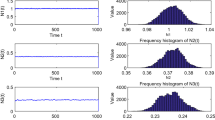In this article, we have considered a simple food-consumer dynamic model in which the supply of food and the death of consumer species play the major role. The parameters representing these factors are allowed to vary with respect to time. It is established that by proper selection of these parameter functions, the system may be made to approach a desired state. It is noticed that these parameters define a space of equilibria for the given system in the limiting case. In case of different consumer species surviving on the same food, when there is no interference in consumption of one by the other, the growth is as desired. Growth is not as desired when one of the species is interfering with the food consumption of the other and the growth of the larger consumer is dominating. By simple variations in the death/removal of dominating species, the situation may be reversed in favor of the other species. The growth is as desired when the parameters are fixed constants. Examples are provided to understand the results and to illustrate various situations. The approach is tried on a popular mathematical model of biology to draw some useful conclusions. The study opens interesting problems for further research.
Similar content being viewed by others
References
Almut Scherer and Angela McLean, “Mathematical models of vaccination,” British Medical Bulletin, 62, No. 1, 187–199 (2002).
G.J. Butler, S.B. Hsu and P. Waltman, “A mathematical model of the chemostat with periodic washout rate,” SIAM J. Appl. Math., 45, No. 3, 435–449 (1985).
W.A. Coppel, Stability and Asymptotic Behaviour of Differential Equations, D.C. Heath and Co., Boston, USA (1965).
J.M. Cushing, “Two species competition in a periodic environment,” J. Math. Biology, 10, No. 4, 385–400 (1980).
J.M. Cushing, “Periodic time-dependent predator prey systems,” SIAM J. Appl. Math., 23, 972–979 (1977).
J.K. Hale and A.S. Somolinos, “Competition for fluctuating nutrient,” J. Math. Biology, 18, No. 3, 225–280 (1983).
S.B. Hsu, “A competition model for seasonally fluctuating nutrient,” J. Math. Biology, 9, No. 2, 115–132 (1980).
M.W. Hirsch, “Convergent activation dynamics in continuous time networks,” Neural Networks, 2, 331–349 (1989).
V.B. Kalmanovskii and V.R. Nosov, Stability of Functional Differential Equations, Academic Press, London (1986).
T.K. Kar and H. Matsuda, “A bioeconomic model of a single-species fishery with a marine reserve,” J. Environ. Management, 86, No. 1, 171–180 (2008).
T. Lindstorm, “Global stability of a model for competing predators: An extension of Ardito and Ricciardi Lyapunov function,” Nonlinear Analysis, 39, 793–805 (2000).
P. Raja Sekhara Rao, K. Venkata Ratnam and P. Lalitha, “Estimation of inputs for a desired output of a cooperative and supportive neural network,” IJETCAS, 9, No. 1, 99–105 (2014).
H.L. Smith and P. Waltman, The Theory of Chemostat, Cambridge University Press, London (1995).
V. Sree Hari Rao and K. Kuppuswamy Rao, “On a nonlinear diffrential-integral equation for ecological problems,” Bull. Austr. Math. Soc., 19, No. 3, 363–369 (1978).
V. Sree Hari Rao and P. Raja Sekhara Rao, Dynamic Models and Control of Biological Systems, Springer, U.S.A (2009).
V. Sree Hari Rao and P. Raja Sekhara Rao, “Time varying stimulations to simple neural networks and convergence to desired output,” Differ. Equat. Dynam. Syst., DOI 10.1007/s12591-016-0312-z (2016).
F. Yang and H.I. Freedman, “Competing predators for a prey in a model with periodic nutrient input,” J. Math. Biology, 29, No. 8, 715–732 (1991).
Author information
Authors and Affiliations
Corresponding author
Rights and permissions
About this article
Cite this article
Raja Sekhara Rao, P., Venkata Ratnam, K. & Lalitha, P. Food-Consumer Interactions: Role of Time – Varying Key Parameters – a New Perspective. Comput Math Model 29, 153–167 (2018). https://doi.org/10.1007/s10598-018-9398-1
Published:
Issue Date:
DOI: https://doi.org/10.1007/s10598-018-9398-1




